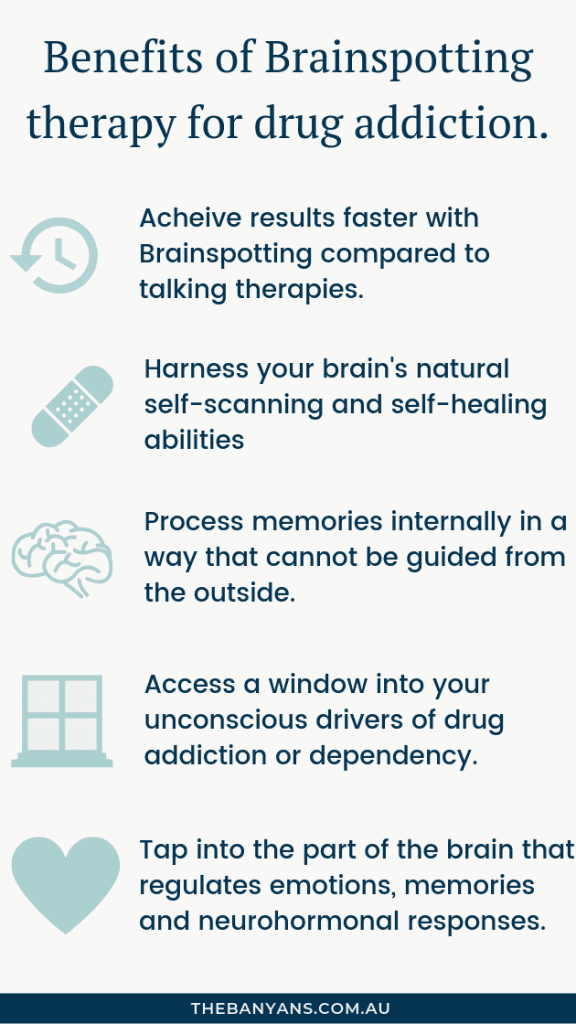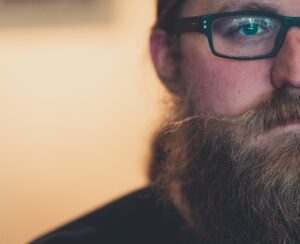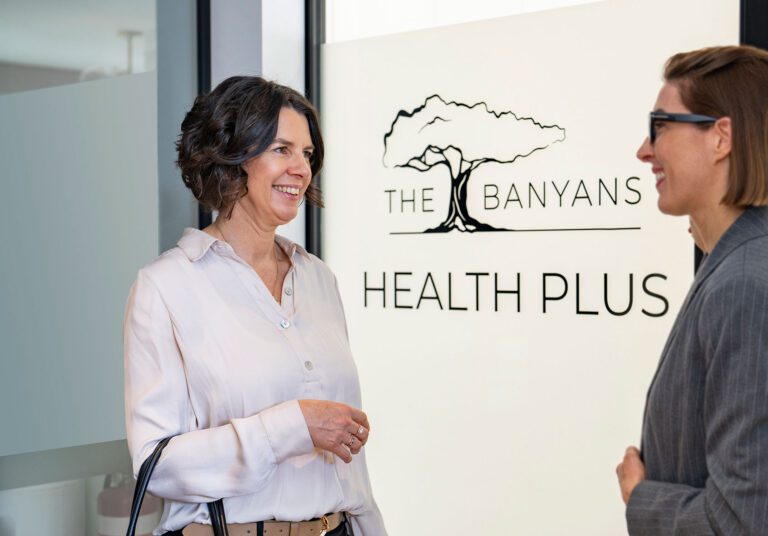
What if there were more to understanding addiction than what we’re generally led to believe? Brainspotting is an emerging form of psychological therapy for drug addiction, offering up a new way of thinking about – and treating – addiction.
This article may be helpful if you’re:
- Curious about treatment and rehabilitation for alcoholism, drug addiction or trauma.
- Looking for a private treatment program for drug addiction or trauma.
- Researching therapies that utilise the natural cognitive connection between sight and emotional distress.
- Interested in emerging psychological therapies like Brainspotting Therapy.
Any form of addiction can have devastating consequences for individuals’ lives and the lives of their loved ones. Across Australia, addiction to drugs and alcohol is more common than many people realise.
The Australian Institute of Health and Wellness reports that over 139,000 people sought treatment services for alcohol and other drugs (AOD) in 2020-2021. Drug addiction can be especially challenging to overcome.
If you or a loved one is addicted to prescription medication or illicit drugs, you have likely experienced the devastating effects it can have on relationships, financial situations, productivity and more.
Peter Hayton, the Clinical Director at The Banyans, explains how a new form of psychological therapy, called Brainspotting, can free people from their addictions, especially drug addiction.
“No one wants to be addicted to drugs,” Peter says. “If you asked someone if they wanted to experience the destructive effects of drug addiction, I doubt many people would say yes.”
Understanding Drug Addiction: Signs & Symptoms
Drug addiction and dependency are one of the leading concerns in Australia. In the past 20 years, the culture surrounding prescription and illicit drug use has changed dramatically, with drug-related deaths reaching a record high in recent years.
What type of person comes to mind when you hear the phrase drug addiction?
Do you think of a middle-aged male misusing prescription drugs, like painkillers such as benzodiazepines or oxycodone?
According to the Australian Bureau of Statistics, these are the Australians most at risk of experiencing drug addiction or accidental death from a drug overdose. Many people may not understand the severity of their drug addiction, especially if they remain capable, high-functioning professionals.
Signs and symptoms of drug addiction to be aware of include:
- Continuing to take medication prescribed for a medical condition that has since healed.
- Requiring an increase in drug dosage to experience its effects.
- Experiencing withdrawal symptoms once the drug/medication wears off, such as headaches, nausea, dizziness, shakes, irritability or very low mood.
- Feeling unable to control the reliance on drug usage.
- Requiring medication or illicit drugs to perform normal daily tasks, relax, wake up or fall asleep.
- Failing to attend to daily tasks due to side effects of drug/medication use, such as drowsiness, poor memory, poor concentration, or lack of physical control of your body.
- Lying about or downplaying how frequently you rely on drugs to get through the day or how you obtain drugs.
- Fixating when you will next be able to engage in drug use.
- Combining medications or drugs with alcohol or other drugs to reach the desired effect.
For more information about the risk of drug addiction in Australia, click here to read our blog on drug addiction and overdose.
What Causes Drug Addiction?
Our brains have an incredible capacity to protect us from stressful experiences and deeply painful emotions. When faced with distressing emotions, feelings or traumatic experiences, we may suppress them as a coping strategy. By redirecting our memories to unconscious parts of our brain, we are sheltered from recalling the overwhelming emotion in unhelpful moments.
“In life, we may have faced difficult emotional situations,” Peter empathises. “To cope with these extremely uncomfortable emotions, our brain can push them away and store them in regions of the brain that we’re unaware of.”
This brain area is called the subcortical region – and we expend up to 90% of our mental energy in subcortical processing. However, these memories are simply hidden – not forgotten.
“We can go on to experience automatic reactions when these suppressed memories or emotions are activated in everyday life,” Peter elaborates.
This is the basis for Brainspotting Therapy. Peter advises the powerful ability of Brainspotting Therapy lies in the ways it addresses some of the unconscious and unknown drivers of drug addiction.
“Brainspotting therapy uses the connection between our eye movements and the subcortical regions of the brain. Through this connection, we can identify and reprocess the suppressed memories contributing to our addictions without our conscious knowledge.”
Unloading Your ‘Emotional Gun’
Peter describes the experience of addiction like a gun:
“If we imagine our experience of addiction and related behaviours as a gun, then engaging in the behaviour is the gun going off. We may be able to identify the triggers – or situations that activate us to seek (and use) the drug,” says Peter. “Brainspotting therapy can help us understand what may be loading the gun in the first place, without us even knowing it.”
Some people experiencing drug addiction may be living their daily lives with a ‘loaded emotional gun’, and it can take very little for them to become triggered, leading them to engage in unhelpful and destructive drug use.
Vision is the King of the Senses
Did you know that 60% of our brain function is dedicated to processing visual stimuli?
Controlled by a structure deep inside the brain, this region also relates to feelings of reward, pleasure and habitual behaviour. We have previously explained how reward, pleasure and habitual pathways are all connected to addiction. To read more about the powerful role of dopamine (the ‘pleasure hormone’).
The deep connection between sight and habitual behaviour has been significant in developing effective psychological treatments for drug addiction. For example, research has suggested that visual cues can begin the addiction circuit without the substance being ingested.
To better understand how sight can influence our behaviour, look at the picture of chocolate above and then reflect on the following questions:
- Did you crave chocolate before you saw the image?
- Do you have a chocolate craving now?
- Can you imagine a time when you had some chocolate?
- How did you feel?
- If you think hard, you can maybe even taste it.
Before seeing the chocolate image, you probably were not even thinking about chocolate. The effect of our suppressed memories can be like what you experienced! When we experience a cue – potentially an emotional or physical cue, we suddenly desire something we did not have before.
Two therapies utilising the relationship between behaviour, emotion and sight are eye movement desensitisation and reprocessing (EMDR) therapy and brain spotting therapy.
How Does Brainspotting Therapy Help With Drug Addiction Treatment?
Brainspotting may sound like science fiction, but it’s very simple.
“Your therapist is there to guide your session and keep you focused; however, all the healing work comes naturally from within you,” Peter confirms. “The brain has a powerful ability to self-scan and heal itself. Your biology has a built-in motivation to relieve physical and emotional discomfort.”
Research has suggested a strong correlation between where we look and how we feel. The position of eyes (rather than the subject we are looking at) seems connected to particular brain areas and can elicit a strong emotional response.
Brainspotting is a flexible therapy similar to EMDR and other somatic therapies. It is based on the principle that where you look affects how you feel. Brainspotting is particularly effective for long-term drug addiction treatment.
Brainspotting provides a window into our unconscious reflexes. It enables identification and awareness of the automatic and unconscious responses driving our drug addiction.
“In a brain spotting session, your therapist will have you look at a pointer. You will be asked to remember a time you felt significantly distressed and proceeded to engage in drug use,” Peter explains. “From there, your therapist will move the pointer and ask you where you feel the emotions most strongly.”
When found, this eye position is called the brain spot, and your therapist will encourage you to hold this position for a dedicated amount of time to explore the feelings and emotions that arise. You may be able to process independently, or your therapist might provide some prompts to help you realign and release these powerful, debilitating emotions.
What is a ‘Brainspot’?
A brain spot is the eye position that activates the emotions connected to your stored, unconscious memory.
In a brainspotting session, your therapist will direct your eye movement with a pointer while you listen to some basic audio stimulation. They will ask you to report when the emotion or distress felt most intense.
When you have identified an eye position that feels particularly strong, the therapist knows that the “brain spot” has been found.
This short video clearly explains a brain spot:
How Brainspotting Can Help Release Emotional ‘Sticky Points’
Many people describe feeling “stuck” in their addiction cycle. Brainspotting helps you identify these emotional “sticky points” and enables you to be free from them.
If the guest does not know why they are stuck in the addiction cycle, their sticky points are likely suppressed emotions. Brainspotting enables the identification of these contributors in a way that cannot be achieved through external, therapist-directed treatments for drug addiction.
Your brain has a natural ability to heal from emotional trauma. Often, this requires processing. Brainspotting brings these unresolved issues to your consciousness so that you can reprocess and release them.
What are the Benefits of Brainspotting for Drug Addiction Treatment?
There are several benefits of brainspotting therapy as a treatment for drug addiction. These include:
- The opportunity for faster results compared to alternative forms of psychological therapy;
- Harness your brain’s natural ability to self-heal;
- Reprocess and acknowledge your internal pain in a way that cannot be directed by a therapist;
- Unlock your unconscious drivers and receive true healing from your addiction;
- Activate the emotional and automatic contributors to addiction, not just the logical side of the brain.
There are many benefits of brainspotting therapy for addiction. This includes deeper insight, faster healing and emotional regulation.
Research into recovery from drug addiction shows that brainspotting therapies can achieve much faster change than traditional talking therapies. Some trained brainspotting therapists describe it as “laser beam therapy”. Brainspotting allows you to focus on a specific unconscious contributor to drug addiction.

Brainspotting For Drug Addiction Treatment at The Banyans
For years, addiction has been viewed as a moral failing or character flaw. But research has shown that this is not the case. Addiction treatment requires a multimodal approach that addresses all contributing factors, including those not yet in the guest’s conscious mind.
Peters suggests that the power of Brainspotting therapy at The Banyans comes from the fact that it is not a stand-alone therapy. “We partner Brainspotting therapy with a variety of other psychological therapies, such as cognitive behavioural therapy (CBT) and other talking therapies.”
“The guest can deeply process all of the underlying contributors to their drug addiction,” Peter says. “You can leave The Banyans knowing that you have addressed all aspects of your drug addiction and are leaving free to start fresh.”
At The Banyans, our private treatment programs for addiction offer one-on-one, personalised Brainspotting and EMDR treatment with qualified therapists. These therapies are paired with powerful talking therapies and ancillary approaches to ensure the guest receives a strong and comprehensive treatment.
If you or someone you know is struggling with drug addiction, reach out for help sooner rather than later. The Banyans expert team are available 24/7 to take your call on 1300 226 926, or submit an online enquiry below.


















